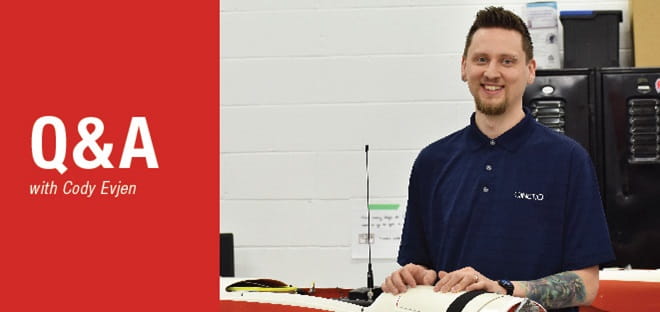Meet Cody Evjen: Computer aided drafting and design grad

Current job: Technical documentation supervisor at QinetiQ Target Systems
Company profile: QinetiQ Target Systems provides a complete target package for high-quality weapon simulation and training programs, improving the skills of military, law enforcement and security personnel. These training systems include unmanned vehicle platforms, scoring systems, payloads, simulation systems and design of specialty systems to meet specific requirements.
Summary of MHC education: Built environment engineering technology (formerly known as computer aided drafting and design)
Q: Can you explain what a "day in the life" looks like for you in your occupation?
On a typical day I work with the technical document staff (technical illustrators, engineering designers and our technical writer) to review drawings and assist with designs. I also do designs of my own, and create technical drawings/publications.
I set aside processes and ensure that those are followed and work closely with the director of engineering in terms of budgeting, estimations, level of efforts and identifying our expertise and skill areas.
Q: How did your education at MHC help you in your career?
The education I received at MHC helped me build the foundation I needed to be able to branch out into a variety of career paths. From there, once I decided the direction I wanted to pursue, I could build on that foundation.
Q: What path has your career taken since you attended college?
As part of the diploma course there was a two week practicum. I had no idea at the time what QinetiQ (formerly known as MEGGITT) did, but I knew what software they used, which was Autodesk Inventor - a program I loved using in college.
I dropped off a resume every two weeks, and called every week, just to get a practicum placement and finally I caught someone’s attention. I came for a two week practicum and about half way through they offered me a summer position. I worked the summer as a student and from there I was given a full time contract working as a technical illustrator. After four years, I was promoted to engineering, design and drafting technologist. I became a certified engineering technologist through the Association of Science and Engineering Technology (ASET), and from here I was promoted to lead. A couple years later, I got my current role. I have continued to further my education and received the project management professional certification through the Project Management Institute (PMI).
Q: What are your future aspirations?
My future aspiration is to get my professional engineering license through the Association of Professional Engineers and Geoscientists of Alberta (APEGA). With this I would be a mechanical engineer, with a more defined scope under that specialty. I am in the process, have submitted and just need to write the national exam.
Q: What do you feel makes the BEET program special?
One of the things that the program has been working towards that I think will be an advantage is that it will be soon accredited and you will be able to go through ASET and be registered as a certified engineering technologist – that’s a huge benefit.
Another benefit is that you are able to establish a good foundation and understanding in all of the disciplines (i.e. civil and mechanical engineering as well as building design technology) which enables you to pursue a variety of career paths.
interested in a similar career? check out

